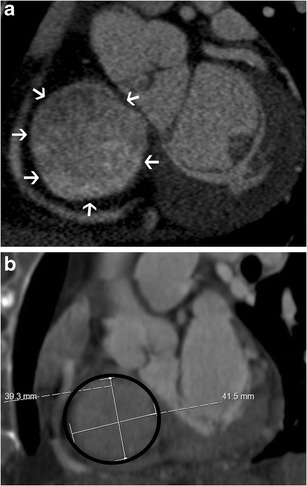Tricuspid stenosis CT scan
Jump to navigation
Jump to search
|
Tricuspid stenosis Microchapters |
|
Diagnosis |
|---|
|
Treatment |
|
Case Studies |
|
Tricuspid stenosis CT scan On the Web |
|
American Roentgen Ray Society Images of Tricuspid stenosis CT scan |
|
Risk calculators and risk factors for Tricuspid stenosis CT scan |
Editor-In-Chief: C. Michael Gibson, M.S., M.D. [1]; Associate Editor(s)-in-Chief: Vamsikrishna Gunnam M.B.B.S [2]
Overview
CT scans may be helpful in giving some exact or more details of the tricuspid valve than of radiographic findings of tricuspid stenosis.
CT scan
- CT scan may be helpful in giving some exact or more details than of radiographic findings of tricuspid stenosis.
- CT scan may be helpful in the tricuspid stenosis by providing in greater details of the following:[1][2][3][4]
- Pre-surgical planning
- Post-surgical follow-up
- Good spatial resolution
- Good temporal resolutions
- Multiplanar reconstruction capability with isotropic resolution
- Calcifications
- Localization of a mass on the valve
- Evaluation of associated extracardiac disorders

OR
There are no CT scan findings associated with [disease name]. However, a CT scan may be helpful in the diagnosis of complications of [disease name], which include:
- [Complication 1]
- [Complication 2]
- [Complication 3]
References
- ↑ Shah S, Jenkins T, Markowitz A, Gilkeson R, Rajiah P (2016). "Multimodal imaging of the tricuspid valve: normal appearance and pathological entities". Insights Imaging. 7 (5): 649–67. doi:10.1007/s13244-016-0504-7. PMC 5028338. PMID 27278389.
- ↑ Ginns J, Ammash N, Bernier PL (2014). "The tricuspid valve in adult congenital heart disease". Heart Fail Clin. 10 (1): 131–53. doi:10.1016/j.hfc.2013.09.019. PMID 24275300.
- ↑ Cawley, Peter J.; Maki, Jeffrey H.; Otto, Catherine M. (2009). "Cardiovascular Magnetic Resonance Imaging for Valvular Heart Disease". Circulation. 119 (3): 468–478. doi:10.1161/CIRCULATIONAHA.107.742486. ISSN 0009-7322.
- ↑ Shah PM, Raney AA (2008). "Tricuspid valve disease". Curr Probl Cardiol. 33 (2): 47–84. doi:10.1016/j.cpcardiol.2007.10.004. PMID 18222317.
- ↑ "Multimodal imaging of the tricuspid valve: normal appearance and pathological entities".